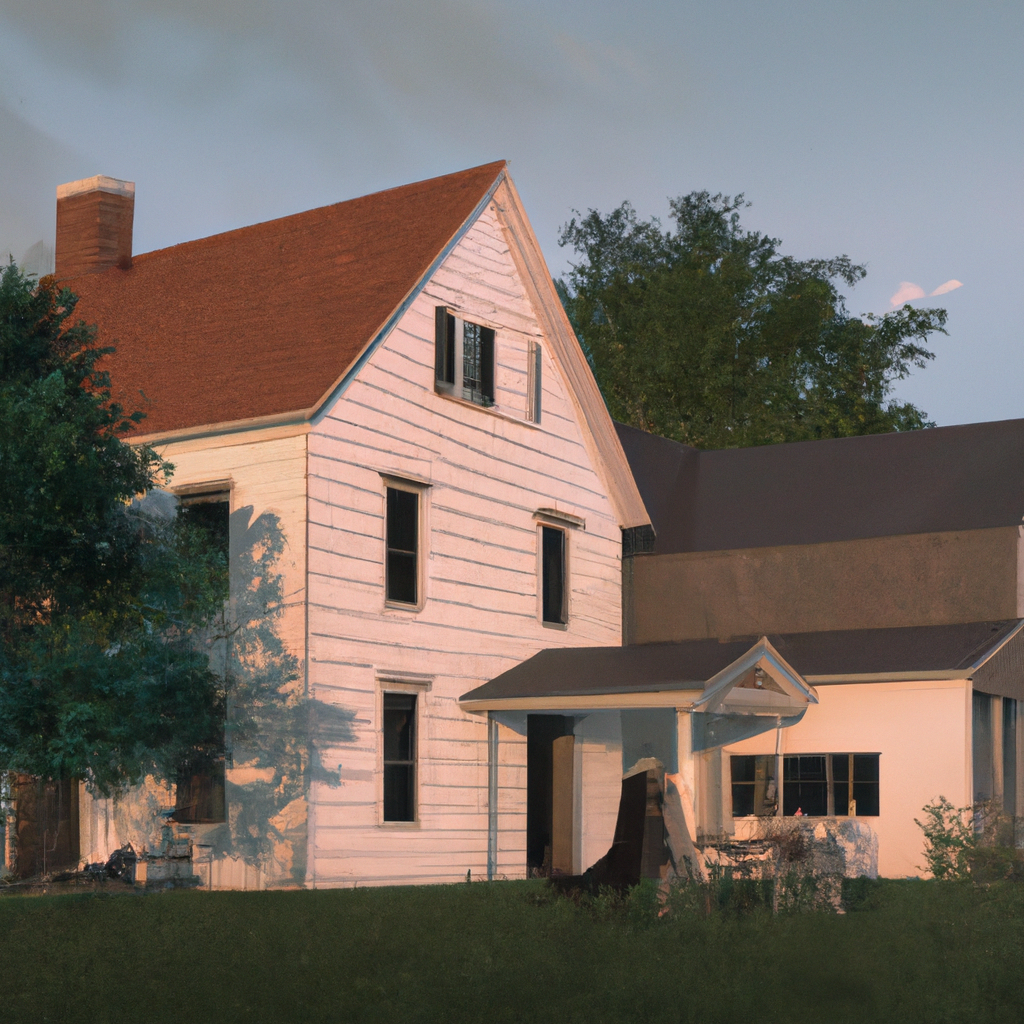Introduction to old farmhouse and modern farmhouse
Old and modern farmhouses vary in style, building materials, and decor. Older farmhouses are characterised by traditional architecture, with wood and brick walls, and a sloping roof. Meanwhile, modern farmhouses embrace rustic and contemporary aesthetics, with open floor plans, large windows, metal roofing, and recycled wood flooring.
Interiors of old farmhouses focus on natural features like stone walls and antique furniture. In contrast, modern farmhouse interiors feature modern technology and smart systems. These two types of farmhouses could not be more different!
Key differences between these two types of farmhouses
To understand the key differences between old and modern farmhouses, you need to evaluate structural design and architecture, use of materials, amenities and features, interior design, and styling. Each of these sub-sections plays a vital role in distinguishing one from the other.
Structural design and architecture
Structural layout and design are key aspects of farmhouse architecture. This affects its strength.
Modern and traditional farmhouses have different designs. Here is a comparison:
| Structural Design | Modern Farmhouse | Traditional Farmhouse |
|---|---|---|
| Roof Pitch | Steep | Gentle |
| Exterior Material | Brick, Wood Cladding | Wood Siding |
| Structural Materials | Steel Beams | Timber Frame |
| Porch Width | Narrow | Wide |
Climate and location also influence the design. For instance, steel beams may be used if the farmhouse is in a place with strong winds or snowstorms.
Pro Tip: Consult a professional architect to build your farmhouse. They will consider all factors and come up with the best plan.
Or, why not try something different – stack old shipping containers together and call it a ‘modern farmhouse’?
Use of materials
Using Diverse Materials
Farmhouses are made with various materials. This creates differences between them.
Look at the table below. It shows how Traditional Farmhouses compare to Modern Farmhouses in terms of materials used.
| Type | Traditional Farmhouses | Modern Farmhouses |
|---|---|---|
| Roofing | Thatched roofs | Metal sheeting, shingles |
| Walls | Mud brick or stone walls | Fiber cement board, stone cladding |
| Flooring | Dirt floors | Wooden or tile flooring |
| Windows | Small openings with wooden shutters | Large, full-length windows |
Traditional Farmhouses use natural elements like thatched roofs, mud brick or stone walls and small openings with wooden shutters. Modern Farmhouses, however, use new techniques with modern materials like metal sheeting, fiber cement board, stone cladding and large windows.
Tip: To get the best outcome, hire an architect skilled in farmhouse styles.
If you want some peace and quiet, move to a farmhouse. You can listen to music as loud as you want and your closest neighbor will still be a mile away.
Amenities and features
Farmhouses are renowned for their exceptional characteristics and luxuries. There are 3 distinguishing features:
- Farmhouse A is traditionally equipped with wooden doors/windows, clay roof tiles, and an old fireplace. Whereas, Farmhouse B has been modernized with temperature control systems and energy-saving lights.
- Farmhouse A offers a tranquil atmosphere close to nature, and Farmhouse B offers recreational activities such as swimming pools and outdoor games.
- Farmhouse A dedicates its outdoor space to agriculture, while Farmhouse B creates children’s playgrounds and pet areas.
Furthermore, some vintage farmhouses have secret rooms in their walls. People can store their valuables there, in case of danger.
One farmer recalls how his grandmother found an old envelope buried under the trees near their farmhouse. When she pulled it out, a wrinkled paper slipped out. It was her grandfather’s savings, hidden during WW2 to protect it from confiscation.
Interior design and styling
When decorating a farmhouse, two styles to consider are the classic and modern. Both rely on natural materials, rustic touches, and vintage finds. Classic uses antique furnishings and floral prints, while modern farmhouses have sleeker finishes and contemporary fixtures. Color palette differs, too – classic uses warmer tones like creams, browns, and reds; modern uses whites, grays, and light blues.
Lighting is an important part of either style – classic has traditional fixtures like chandeliers; modern has industrial-style lighting. Curtains also differ – classic has heavier fabrics with floral patterns; modern uses lighter fabrics like linen or cotton with simple patterns or solid colors. Furniture also differs – classic has a mix of upholstered pieces with rustic or weathered wooden furniture; modern has clean lines and simple designs.
Although different, both styles have roots in American history. Classic from colonial times; modern from 20th century rural architecture. To create charm and warmth, natural materials and vintage nods must be used. Understanding the differences between the two will help you achieve your desired look. And, of course, both attract a lot of flies!
Similarities between old and modern farmhouses
To explore the similarities between old and modern farmhouses, delve into farmhouse culture and lifestyle as well as the role of farmhouses in agriculture and rural economy.
Farmhouse culture and lifestyle
Farmhouse traditions have stayed the same through the years. Both old and modern farmhouses feature steep roofs, simple shapes, and big windows. Natural materials like wood, stone, and brick are common in both. Living remotely brings people together helping each other with harvests and repairs. Food from the land also provides fuel, building materials, and medicine.
However, family-owned farms are shrinking across Europe. Nevertheless, those that remain are keeping up with these customs in modern ways. We can take part too! Such as using natural materials like wooden furniture and buying locally produced goods as farmland disappears. I guess you could say that a farmhouse gives us a home-grown benefit!
Role of farmhouses in agriculture and rural economy
Farmhouses have been essential for centuries, housing agricultural workers and storing equipment, grain, and livestock. They also represent an important part of traditional architecture, culture, and history.
Today, farmhouses are even more important. Technology and farming techniques have changed them from shelters to efficient hubs. They provide storage, office spaces, and livestock care.
But that’s not all. Modern farmhouses also promote tourism. Luxurious accommodations get guests looking for a unique experience. Local food and activities add economic value.
An example is a dairy farm in Vermont that operates a guesthouse during peak months. Visitors come for the authentic country-living experience, while supporting local businesses. Activities include cheese making workshops and cooking classes with local ingredients.
Farmhouses remain symbols of resilience. Old ones have charm, but modern ones have indoor plumbing!
Pros and cons of old and modern farmhouses
To understand the pros and cons of old and modern farmhouses, the following sub-sections need to be explored: the advantages of old farmhouses, the disadvantages of old farmhouses, the benefits of modern farmhouses, and the drawbacks of modern farmhouses.
Pros of old farmhouses
Old-Time Farmhouse Living: Advantages and Considerations.
Old farmhouses have many attractive features not found in modern homes. Here are some of the perks:
- History and charm: Older farmhouses have a sense of history and classic architectural beauty.
- Solid construction: Most older homes were built with sturdy materials like hand-hewn timber, stone, and brick.
- Spaciousness: Older farmhouses are generally bigger than modern homes, providing plenty of space for families or guests.
- Large outdoor spaces: Old farmhouses often have extensive lands with fields and pastures, perfect for gardening or enjoying nature.
However, older farmhouses come with certain cons such as expensive maintenance fees.
If you’re thinking of buying one, there are ways to preserve the building’s charm while making it functional. Adding efficient HVAC systems can reduce energy bills. Engaging preservation builders ensures work done on the house won’t compromise its architectural authenticity or structural safety.
By taking these steps, you can live in a beautiful place from a bygone era – but be prepared for possible plumbing issues!
Cons of old farmhouses
Old farmhouse drawbacks: Reasons to consider modern options.
Old farmhouses may seem enchanting and idyllic, but they come with a few drawbacks. Three reasons why old farmhouses come with a caveat:
- Outdated infrastructure – limited storage, plumbing and electrical systems.
- High maintenance costs – repairs and renovations are expensive and time-consuming.
- Lack of energy efficiency – poor insulation, windows that leak air and reduced temperature control.
Despite the drawbacks, old farmhouses still offer a chance to own a historic piece of nostalgia. It’s important to consider the drawbacks before buying.
Pro Tip: Run a thorough inspection and hire professionals for a retrofit upgrade if needed.
Modern farmhouses: Where the only thing outdated is the term ‘farmhouse’!
Pros of modern farmhouses
Modern farmhouses are a big step up from traditional ones, boasting three main advantages:
- Using more innovative construction materials makes them strong and able to withstand rough weather.
- They come with tech-savvy features that make sustainability and water management more efficient.
- Their design provides farmers with higher productivity through better-equipped workshops and storage spaces.
Plus, they come with unique features like big windows for natural light and ventilation.
A farmer in Southern California upgraded his old farmhouse with solar panels that power the whole place up, supplying electricity for the farm.
Though modern farmhouses may be fancy, they lack the character of an original farmhouse.
Cons of modern farmhouses
Modern Farmhouses: Not All Sunshine and Rainbows.
Costs for modern farmhouses are usually higher than traditional ones. Character and tradition may be lost due to pre-designed plans. People may need to rely on electricity for basic amenities.
Weighing the pros and cons before buying is key. Everyone has their own preference, so it’s subjective. A friend once invested in a brand new farmhouse only to find issues. It’s like deciding between a vintage wine or a new blend – it depends on taste and investment.
Conclusion and recommendations for choosing between old and modern farmhouses
Old vs. Modern Farmhouses? Consider This!
Comparing the two styles of farmhouses can be tricky. Old farmhouses often have intricate designs, plus unique materials such as reclaimed wood and corrugated metal roofing. But modern farmhouses are usually simpler, and offer more functionality.
So what should you choose? It depends on your lifestyle needs. If you want a house with character and don’t mind the maintenance, then an old farmhouse may be best. But if you prefer updated amenities and a sleek design, then go for a modern one.
Regardless of style, make sure the farmhouse meets local building codes and safety standards. According to South Dakota State University Extension, the physical environment has an effect on behavior. So choose wisely!


